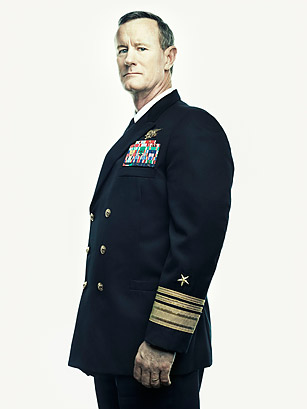
(2 of 4)
The New American Commandos
Once there were U.S. commando units in World War II. Once there was a President who called for building up the Green Berets in the same speech, in 1961, that called for landing a man on the moon. But occupied France and John F. Kennedy are not what usually come to mind when special operators look for a reference point. The date that seared itself into their collective memory is April 24, 1980.
The Desert One hostage-rescue mission in Iran that day, aborted in a spectacle of flaming aircraft, left eight Americans dead and the nation's prestige badly burned. McRaven grew up as an officer in the aftermath. His story — with the near fatal jump accident and, before that, the ignominious loss of his first command — fit the narrative of setback and redemption in the special-operations community writ large.
Long before the bin Laden raid, the special operators came to believe they had rebuilt themselves as a stealthy, lethal and strategically potent military force. They had doubled their size and tripled their budget since 9/11, and 10 years of high-tempo combat missions had honed their skills in Iraq, Afghanistan and theaters of war they did not usually acknowledge: Somalia, Yemen, Tanzania, Kenya, Indonesia, the Philippines — and Pakistan, where bin Laden's compound was not the first to receive callers from JSOC.
"They went through a period of appearing more like cowboys, a period of 'tried but didn't quite make it,' " said retired Marine general James Cartwright, who was vice chairman of the Joint Chiefs of Staff when the raid took place. "It has been since 9/11 that both their utility and then their expertise have become the cutting edge."
On the night of the bin Laden raid, there were 13 simultaneous operations in Afghanistan by clandestine "special-mission units" under JSOC, according to McRaven and Petraeus. Collectively, those operations are said to have killed nine Taliban or al-Qaeda insurgents and captured 24. The most recent internal tally counted more than 2,500 such commando missions in and around Afghanistan over 12 months.
"There now has been an accumulation through the course of 2011 of very significant losses in core al-Qaeda and also the affiliates in Yemen and some of the other offshoots," Petraeus says, citing two al-Qaeda figures, Atiyah Abdel Rahman in Pakistan and Anwar al-Awlaki in Yemen, whose deaths have not been officially acknowledged as JSOC's work. "All in all, a pretty good year," McRaven says, "but frankly it has been a big year for us really since 9/11."
According to participants in the closely held Abbottabad debate, McRaven spoke thoughtfully about the risks but never expressed doubt that his men could dispatch bin Laden and return home safely.
"One of the things we made clear to the President and the national leadership was, This is what we do," he told TIME. "We do raids. We fly in by helicopters, we assault compounds, we, you know, we grab the bad guy or whatever is required, and we get out. So admittedly that particular operation was a lot sportier, a lot further, a lot more political ramifications, a lot riskier for a lot of reasons, but basically similar to things that we do every night."
Secret Agent Man
McRaven grew up with war stories. According to Nan McRaven, one of two older sisters, their father Claude regaled the family with accounts of his exploits as a fighter pilot in British-built Spitfires during World War II. It was scuba diving that captured young Bill McRaven's imagination. When McRaven was 10, Sean Connery's James Bond spent a lot of screen time in Thunderball pummeling underwater bad guys and making out with Domino, the underwater hottie. "That was his favorite!" Nan McRaven says. "I said to him, 'You can grow up to be 007.' I guess he did."
McRaven signed up for Navy ROTC at the University of Texas, wooed Georgeann Brady at Alpha Delta Pi and majored in journalism at the peak of the profession's post-Watergate élan. He graduated in 1977 with an ensign's commission, signed up for SEAL training, married Georgeann and deployed to the Philippines.
A lucky break came his way, it seemed, in 1982, two years after the hostage-rescue debacle. The Navy brass had established a secret counterterrorist unit under Commander Richard Marcinko, a creative, mercurial and extravagantly profane enthusiast of commando arts.